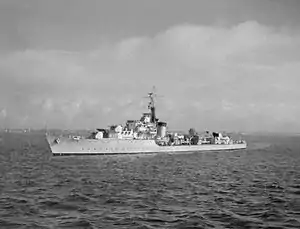HMS Zephyr (R19)
HMS Zephyr was a Z-class destroyer. She was launched on 13 July 1942 at Vickers-Armstrong on Tyneside and commissioned on 6 September 1944. She was 'adopted' by the civil community of Doncaster, replacing the destroyer HMS Lightning (sunk in 1943), which had originally been adopted during Warship Week in 1942.
 HMS Zephyr underway off Spithead, 5 May 1952 | |
| History | |
|---|---|
| Name: | HMS Zephyr |
| Ordered: | 12 February 1942 |
| Laid down: | 13 July 1942 |
| Launched: | 15 July 1943 |
| Commissioned: | 6 September 1944 |
| Identification: | Pennant number R19 |
| Honours and awards: | Quebec 1759 - Martinique 1762 - Copenhaged 1801 - Baltic 1854 - Arctic 1945 |
| Fate: | Arrived in Dunston for breaking up 2 July 1958 |
| Badge: | On a Field Blue, a representation of Zephyrus, the West wind |
| General characteristics | |
| Class and type: | Z-class destroyer |
| Displacement: | 1,710 tons |
| Length: | 362 ft 9 in (110.57 m) |
| Beam: | 35 ft 8 in (10.87 m) |
| Draught: | 10 ft (3.0 m) |
| Propulsion: | Twin steam turbines |
| Speed: | 37 knots (69 km/h) maximum |
| Complement: | 185 |
| Armament: | |
Second World War
After a period of working up with ships of the Home Fleet at Scapa Flow she joined the 2nd Destroyer Flotilla, Home Fleet for screening duty and patrol on the North Western Approaches. During anti-submarine operations on 31 December 1944 Zephyr was damaged in an explosion off of the Pentland Firth.[1] She resumed duties in April 1945 following repair and she escorted a number of Arctic convoys, and other operations in the North Sea and off the coast of Scandinavia. As the war reached its end Zephyr stopped at Copenhagen with other Royal Navy ships to accept the surrender of a number of German warships. She was also deployed with the Home Fleet to support operations to re-occupy countries previously under German occupation, and this included guardship duties.
Postwar
Between August 1946 and May 1947 Zephyr was part of the 4th Destroyer Flotilla as part of the Home Fleet. Between July 1947 and February 1948 the destroyer was with the Portsmouth Flotilla as Gunnery ship. In February 1948 she transferred to the 3rd Escort Flotilla, based at Portland. In February 1949 she was leader of the 2nd Training Flotilla. In June 1953 she attended the Coronation Review at Spithead.[2]
She was paid-off in 1954 and was reduced to reserve status in the Portsmouth Reserve Fleet where she stayed until 1958.[3]
Decommissioning and disposal
The ship was nominated for conversion to an anti-submarine frigate and her main armament was to be removed. However, in 1955 this work was cancelled and the ship was placed on the Sale List. She was sold to Clayton and Davie and arrived at their yard at Dunston on 2 July 1958 for scrapping.
References
- "HMS Zephyr (R 19)". uboat.net. Retrieved 4 January 2015.
- Souvenir Programme, Coronation Review of the Fleet, Spithead, 15th June 1953, HMSO, Gale and Polden
- Critchley, Mike (1982). British Warships Since 1945: Part 3: Destroyers. Liskeard, UK: Maritime Books. p. 80. ISBN 0-9506323-9-2.
Publications
- Colledge, J. J.; Warlow, Ben (2006) [1969]. Ships of the Royal Navy: The Complete Record of all Fighting Ships of the Royal Navy (Rev. ed.). London: Chatham Publishing. ISBN 978-1-86176-281-8.
- Marriott, Leo (1989). Royal Navy Destroyers Since 1945. Ian Allan Ltd. ISBN 0-7110-1817-0.
- Raven, Alan; Roberts, John (1978). War Built Destroyers O to Z Classes. London: Bivouac Books. ISBN 0-85680-010-4.
- Whitley, M. J. (1988). Destroyers of World War 2. Annapolis, Maryland: Naval Institute Press. ISBN 0-87021-326-1.
